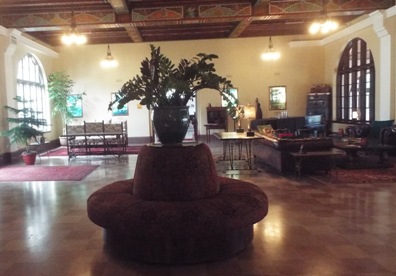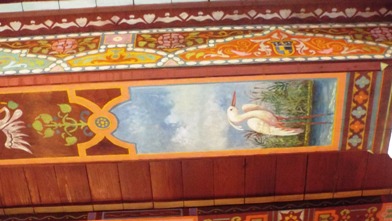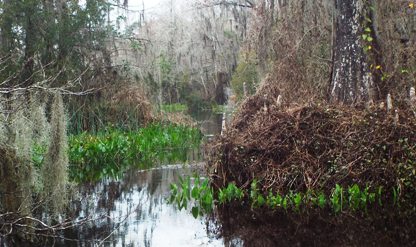Warm weather and pristine white beaches are typically the
draw for mid-westerners. But Florida
offers a variety of options for the visitor. In northwest Florida, about eighty miles inland, is Wakulla Springs State Park and Lodge.
 |
Wakulla Springs, a strange and mysterious place in
northwest Florida, is only a few miles from the state capitol |
 |
| The Wakulla River, downstream from the spring, gives a feeling of total isolation |
 |
| The spring is home to alligators and the occasional manatee |
 |
| Vultures perch on a tree branch above the river |
A 6,000-acre wildlife sanctuary can be found in the
Spanish moss-draped woodlands just thirty minutes southeast of Tallahassee. Here, Wakulla Springs creates one of the last
pristine rivers, the Wakulla River, in Florida.
"Wakulla" may be a modern spelling of ancient Native American
origin meaning "river of the crying bird" or
"mystery." Spanish explorers
interpreted the Indian word for the spring as guarcura. The Creeks
modified the word and the Seminoles, in the late 18th century, began calling
the river Wakala. Kala
is said to mean "a spring of water."
 |
The Anhinga bird dives deep into the water for fish, and
then dries his wings by spreading them in the sun |
 |
| The Great Blue Heron with a flock of smaller white birds |
 |
| Cypress knees |
 |
| Some of the cypress found in the river was used in constructing the lodge |
Wildlife and a vast array of birds -- over 182 varieties
depending upon the season -- can be observed by hiking the nature trails,
taking an hour-long river cruise, or when water conditions permit, a
glass-bottom boat ride over the bowl of the spring, one of the world's largest
and deepest springs.
 |
Other than this fleet of excursion boats operated by the Park Service,
no boats are allowed on the spring or the Wakulla River |
 |
The rear of the lodge, and a diving platform as seen
from one of the excursion boats on the spring |
 |
| View of the spring from the rear of the lodge |
 |
"Old Joe", an 11-foot alligator who lived in the river, was estimated to be as old
as 300 years. When he was killed by a poacher in 1966, he was stuffed and put
on display. A $5,000 reward was offered for his killer, but was never claimed |
Wakulla Springs has been commercially developed since
1844 when tours were offered to the public by a Mr. P. Randall. When Edward Ball, brother-in-law and business
manager to Alfred DuPont, first saw the site, he knew it should be preserved. At the time Mr. Ball was scouring the area to
purchase land to grow pulpwood for the production of paper. His love for the area led him to begin buying
up land starting in 1931 in an effort to keep the environs in as much of a
natural state as possible.
 |
Edward Ball, born March 21, 1888, died June 24, 1981.
Mr. Ball kept a suite at the lodge until his death |
Ed Ball personally handled the design and
construction of the two-story lodge. Construction began in 1935 and was
completed in 1937. The style of
architecture is Mediterranean Revival which combines Spanish-Moorish and art
deco motifs. Mr. Ball was a stickler for
detail and craftsmanship, with the intention of creating a beautiful and
lasting structure.
 |
| Front entrance of the lodge |
 |
| Close-up of the front entrance |
 |
| A fire escape from the second floor of the building |
 |
| The rear of the lodge, as seen from the area of the spring |
There is lavish use of marble throughout the lodge. Most of the permanent appointments from
floors to windowsills are made of
marble. The world's longest marble bar -- seventy feet, three inches in
length -- is located in what is now the gift shop and ice cream parlor. Most of the marble came "rough cut"
from Tennessee and was "finish-cut" and fitted on site.
 |
| The ice cream parlor boasts the world's longest marble bar, at 70 feet, 3 inches |
 |
The bar is made of eight marble panels, all with matched grains.
cut on site from a single block of marble. |
 |
| The dining room |
 |
| Circular couch in the lobby |
 |
| The lobby is comfortably furnished in rich maroon leather. |
 |
The use of marble extends to gaming tables placed throughout
the lobby and the ice cream parlor |
 |
The elevator is the oldest still-working art deco
elevator in the United States. The interior
walls are walnut with inlaid marquetry panels. |
Every aspect of the Lodge reflects the attention to
detail in the high quality of material and craftsmanship.
 |
The ceiling is made from the "hearts" of cypress trees that had fallen into the
cold water. Immersed for 50 or more years, they are impervious to rot |
 |
| The paintings on the ceilings are by a German artist named Mr. Piplack. |
 |
It was later discovered that Herr Piplack was the last court
painter for Germany's Kaiser Wilhelm |
 |
A massive fireplace is the focal point of the lobby. It appears to be cut
stone but is, in fact, a special light-weight, air-impregnated poured
concrete, grouted and finished to resemble actual stone |
 |
The hand-wrought iron Limpkin (here) and Heron (below)
on the balustrade of the main stairs are life-sized |
 |
The stair treads are marble and the risers are granite.
The marble is matched grain, cut from a single block |
 |
The guest rooms have been refurbished and fitted with the latest amenities,
but still retain the elegance and ambiance of the original rooms |
 |
This is the terrace ballroom. The entrance to the lobby is a two-door
Moorish archway surrounded by mosaic tiles hand-made in Spain |
As bucolic as the spring is and as impressive as the
historic lodge is there is another fun side to Wakulla. The site has been has been the featured location for numerous
movies. Two "Tarzan" movies
starring Johnny Weismueller were
filmed at Wakulla Springs, as were the underwater scenes in "Airport
'77". But the most notable
film to be shot at Wakulla Springs is the cult classic "The
Creature From The Black Lagoon".
 |
The 1954 black-and-white horror film, now a cult
classic, was filmed at Wakulla Springs. |
 |
| This little creek, off the main spring, was the creature's "lair" |
 |
The creature's head was modeled after the head of the
Oscar statue, given to Academy Award winners |
In the less-visited Florida Panhandle, far from the
crowds of Orlando or the excitement of the Space Coast, in an area that bills
itself as "The Forgotten Coast",
we found the strange and mysterious waters of the "River of the Crying Bird" and learned a few more Road
Stories.